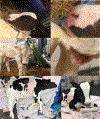Overgrowth Syndrome
- PMID: 31103180
- PMCID: PMC6527122
- DOI: 10.1016/j.cvfa.2019.02.007
Overgrowth Syndrome
Abstract
Large offspring syndrome (LOS) is a fetal overgrowth condition in bovines most often observed in offspring conceived with the use of assisted reproductive technologies (ART). Phenotypes observed in LOS include, overgrowth, enlarged tongues, umbilical hernias, muscle and skeleton malformations, abnormal organ growth and placental development. Although LOS cases have only been reported to be associated with ART, fetal overgrowth can occur spontaneously in cattle (S-LOS). S-LOS refers to oversized calves that are born at normal gestation lengths. ART-induced LOS has been characterized as an epigenetic syndrome, more specifically, a loss-of-imprinting condition. We propose that S-LOS is also a loss-of-imprinting condition.
Keywords: Abnormal offspring syndrome; Assisted reproduction; Large offspring syndrome; Overgrowth; Spontaneous LOS.
Copyright © 2019 Elsevier Inc. All rights reserved.
Figures


Similar articles
-
Aberrant CpG methylation of the imprinting control region KvDMR1 detected in assisted reproductive technology-produced calves and pathogenesis of large offspring syndrome.Anim Reprod Sci. 2010 Dec;122(3-4):303-12. doi: 10.1016/j.anireprosci.2010.09.008. Epub 2010 Oct 7. Anim Reprod Sci. 2010. PMID: 21035970
-
Characterization of global loss of imprinting in fetal overgrowth syndrome induced by assisted reproduction.Proc Natl Acad Sci U S A. 2015 Apr 14;112(15):4618-23. doi: 10.1073/pnas.1422088112. Epub 2015 Mar 30. Proc Natl Acad Sci U S A. 2015. PMID: 25825726 Free PMC article.
-
Large offspring syndrome: a bovine model for the human loss-of-imprinting overgrowth syndrome Beckwith-Wiedemann.Epigenetics. 2013 Jun;8(6):591-601. doi: 10.4161/epi.24655. Epub 2013 May 10. Epigenetics. 2013. PMID: 23751783 Free PMC article.
-
Assisted reproductive technologies and birth defects.Congenit Anom (Kyoto). 2005 Jun;45(2):39-43. doi: 10.1111/j.1741-4520.2005.00061.x. Congenit Anom (Kyoto). 2005. PMID: 15904430 Review.
-
[Epigenetic perspectives of safety in assisted reproductive technologies].Genetika. 2007 Sep;43(9):1157-71. Genetika. 2007. PMID: 17990514 Review. Russian.
Cited by
-
Spontaneous and ART-induced large offspring syndrome: similarities and differences in DNA methylome.Epigenetics. 2022 Nov;17(11):1477-1496. doi: 10.1080/15592294.2022.2067938. Epub 2022 May 3. Epigenetics. 2022. PMID: 35466858 Free PMC article.
-
Differentially expressed tRNA-derived fragments in bovine fetuses with assisted reproduction induced congenital overgrowth syndrome.Front Genet. 2022 Nov 15;13:1055343. doi: 10.3389/fgene.2022.1055343. eCollection 2022. Front Genet. 2022. PMID: 36457750 Free PMC article.
-
Allele-specific aberration of imprinted domain chromosome architecture associates with large offspring syndrome.iScience. 2022 Apr 20;25(5):104269. doi: 10.1016/j.isci.2022.104269. eCollection 2022 May 20. iScience. 2022. PMID: 35542046 Free PMC article.
-
Epigenetic Reprogramming and Somatic Cell Nuclear Transfer.Methods Mol Biol. 2023;2647:37-58. doi: 10.1007/978-1-0716-3064-8_2. Methods Mol Biol. 2023. PMID: 37041328 Review.
-
Defining Candidate Imprinted loci in Bos taurus.Genes (Basel). 2023 May 2;14(5):1036. doi: 10.3390/genes14051036. Genes (Basel). 2023. PMID: 37239396 Free PMC article.
References
-
- Lapunzina P Risk of tumorigenesis in overgrowth syndromes: a comprehensive review. Paper presented at: American Journal of Medical Genetics Part C: Seminars in Medical Genetics 2005. - PubMed
-
- Young LE, Sinclair KD, Wilmut I. Large offspring syndrome in cattle and sheep. Rev Reprod. September 1998;3(3):155–163. - PubMed
-
- Sinclair K, Young L, Wilmut I, McEvoy T. In-utero overgrowth in ruminants following embryo culture: lessons from mice and a warning to men. Human Reproduction. 2000;15(suppl_5):68–86. - PubMed
-
- Opitz JM, Weaver DW, Reynolds JF. The syndromes of Sotos and Weaver: reports and review. American Journal of Medical Genetics Part A. 1998;79(4):294–304. - PubMed
-
- Elliott M, Bayly R, Cole T, Temple IK, Maher ER. Clinical features and natural history of Beckwith-Wiedemann syndrome: presentation of 74 new cases. Clinical genetics. August 1994;46(2):168–174. - PubMed
Publication types
MeSH terms
Grants and funding
LinkOut - more resources
Full Text Sources
Medical

